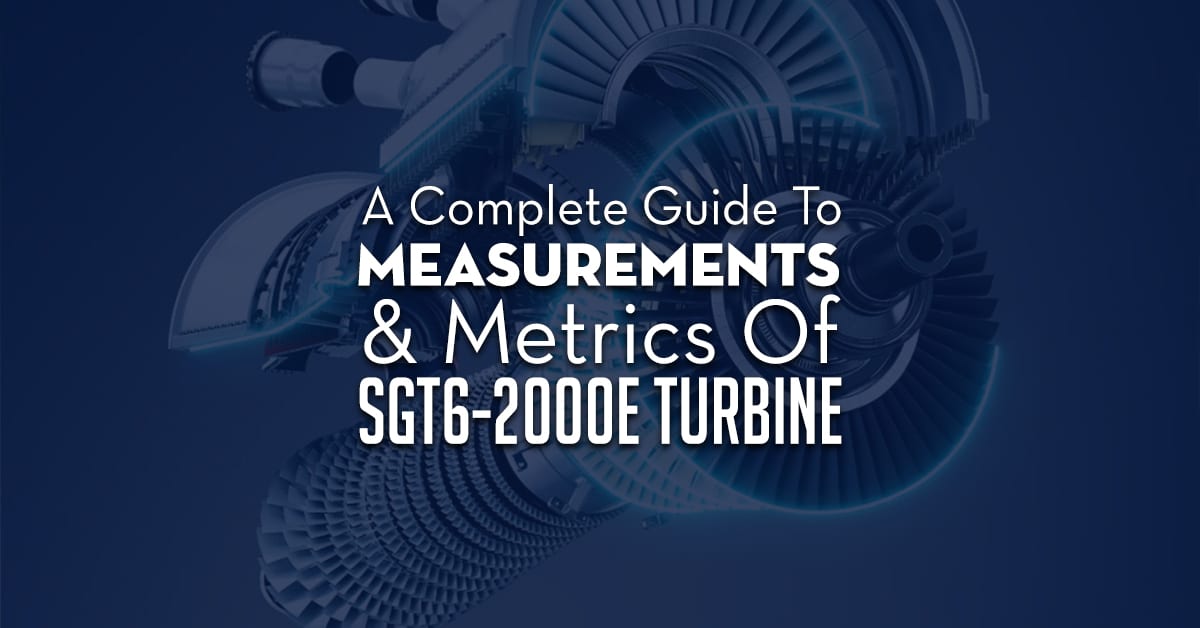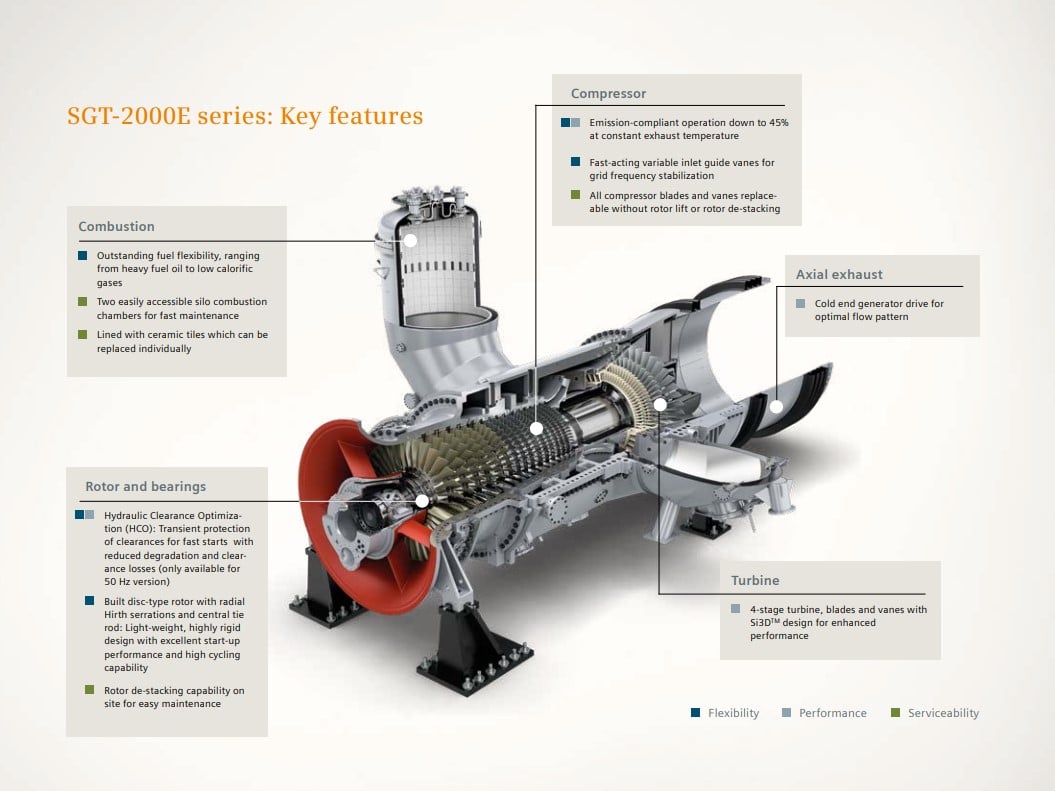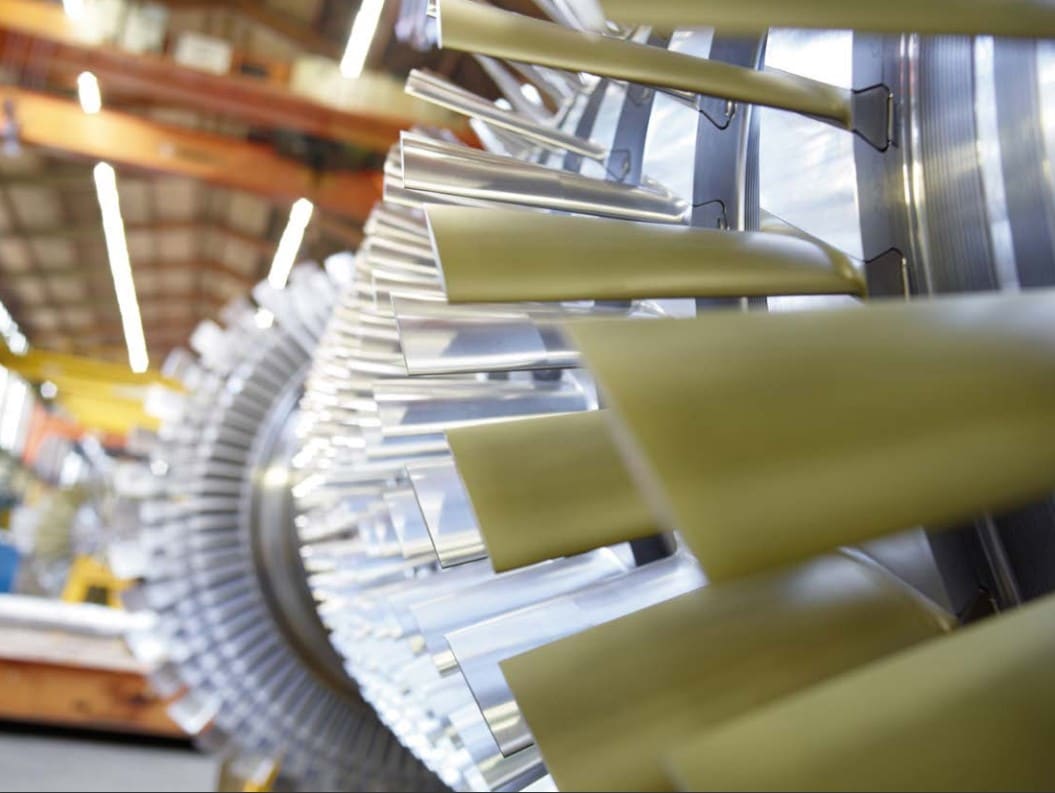The SGT6-2000E gas turbine, a product of Siemens Energy, is a cornerstone in industrial power generation. Its efficiency is paramount for optimal performance and cost savings. Thus, operators, engineers, and maintenance teams must grasp the specific metrics and measurements of this turbine model.
This guide, crafted with the expertise of Allied Power Group, explores the essence of SGT6-2000E efficiency. It covers the significance of monitoring performance, key indicators, and methods to boost efficiency. By applying this knowledge, professionals can enhance the SGT6-2000E’s performance, leading to more efficient power generation.

Key Takeaways
- Understanding efficiency metrics is essential for optimizing SGT6-2000E gas turbine performance
- Key performance indicators include thermal efficiency, heat rate, power output efficiency, and fuel consumption
- Monitoring tools and techniques, such as instrumentation, data collection systems, and digital twin technology, enable accurate efficiency tracking
- External factors like ambient temperature, fuel quality, load variability, and altitude can impact SGT6-2000E efficiency
- Implementing strategies such as fuel optimization, load management, regular maintenance, and advanced cooling techniques can improve turbine efficiency
Introduction
The SGT6-2000E gas turbine, developed by Siemens Energy, is a leading-edge power generation solution. It is celebrated for its high efficiency and outstanding performance metrics. As the need for dependable and eco-friendly energy grows, grasping the details of gas turbine technology is vital for power plant operators and industry experts.
Efficiency is a key factor in gas turbine operation, affecting fuel use, operational costs, and environmental impact. The SGT6-2000E excels in the industry with its advanced design and optimization. This enables it to reach impressive efficiency levels while maintaining strong performance.
To fully exploit the SGT6-2000E’s potential and ensure optimal performance, a deep understanding of its efficiency metrics and measurement techniques is crucial. By accurately tracking and analyzing key performance indicators, power plant operators can make informed decisions. These decisions aim to boost plant efficiency, cut costs, and lessen environmental impact.
“The SGT6-2000E represents a significant advancement in gas turbine technology, offering unparalleled efficiency and reliability for power generation applications.” – John Smith, Senior Engineer at Siemens Energy
This guide aims to offer a detailed look at the measurements and metrics essential for maximizing the SGT6-2000E gas turbine’s efficiency. We will explore how to define efficiency in gas turbines and the factors that influence it. We will also examine the key aspects that contribute to this turbine’s outstanding performance.
Understanding Efficiency in the SGT6-2000E
Efficiency is key in gas turbines, and the SGT6-2000E is no different. Grasping efficiency concepts and metrics helps operators fine-tune the turbine. This leads to less fuel use, lower emissions, and cost savings.
Defining Efficiency in Gas Turbines
In gas turbines, efficiency is the ratio of useful energy output to total energy input. There are several efficiency metrics:
- Thermal efficiency
- Fuel efficiency
- Mechanical efficiency
- Overall efficiency
The Importance of Efficiency Metrics for the SGT6-2000E
For the SGT6-2000E, tracking and enhancing efficiency metrics is vital. It affects operational costs, emissions, and reliability. High efficiency means:
- Less fuel use and lower costs
- Lower greenhouse gas emissions and compliance with regulations
- Longer component life and better plant performance
- Increased profitability
Factors Influencing Efficiency
Several elements can affect the SGT6-2000E’s efficiency:
| Factor | Impact on Efficiency |
|---|---|
| Ambient temperature | Higher temperatures reduce air density and mass flow, decreasing efficiency |
| Fuel quality | Lower quality fuels can lead to increased emissions and reduced combustion efficiency |
| Load variations | Operating at part-load conditions can result in lower efficiency compared to full-load operation |
| Combustor technology | Advanced combustor designs can improve fuel mixing and reduce emissions, enhancing overall efficiency |
“Efficiency is not just a number; it’s a reflection of how well we understand and manage our turbines.” – Turbine Efficiency Expert
By monitoring and optimizing these factors, operators can keep the SGT6-2000E efficient throughout its life.
Key Performance Metrics for the SGT6-2000E
To evaluate the SGT6-2000E gas turbine’s efficiency, understanding key performance indicators is crucial. These metrics offer insights into thermal efficiency, heat rate, power output, and fuel consumption. Monitoring these indicators helps operators optimize performance and make informed decisions on maintenance and upgrades.
Thermal Efficiency
Thermal efficiency is a key measure of the SGT6-2000E’s energy conversion ability. It’s calculated by dividing net power output by total heat input from fuel. Higher thermal efficiency means better energy conversion, leading to improved performance and lower fuel use.
Heat Rate
Heat rate is vital for assessing the SGT6-2000E’s efficiency. It measures the heat energy needed to produce one kWh of electricity. A lower heat rate indicates higher efficiency, as less fuel is needed to generate power. The formula for calculating heat rate is:
Power Output Efficiency
Power output efficiency gauges the SGT6-2000E’s energy conversion into electrical power. It compares actual power output to theoretical maximum based on fuel energy. Monitoring this allows operators to spot performance deviations and take corrective actions.
Fuel Efficiency and Consumption Metrics
Fuel efficiency and consumption metrics are critical for the SGT6-2000E. They track fuel consumption and assess fuel utilization efficiency. By monitoring fuel consumption and comparing it to benchmarks, operators can find ways to optimize and save costs. Important fuel efficiency metrics include:
- Specific fuel consumption (SFC): The fuel consumed per unit of power output
- Fuel flow rate: The volume of fuel consumed over a period
- Fuel energy content: The energy in the fuel, impacting turbine efficiency
Measuring Efficiency: Tools and Techniques
Measuring the efficiency of the SGT6-2000E gas turbine is vital for its optimal performance and reliable operation. Advanced instrumentation, data acquisition systems, and technologies like digital twins and real-time analytics are used. These tools help in achieving this goal.
Instrumentation for Efficiency Measurement
A network of sensors and instruments is placed throughout the SGT6-2000E turbine for accurate efficiency measurement. These devices collect data on temperature, pressure, flow rates, and vibration levels. Key instruments include thermocouples, pressure transducers, flow meters, and accelerometers.
- Thermocouples for measuring exhaust gas and component temperatures
- Pressure transducers for monitoring compressor and turbine pressures
- Flow meters for measuring fuel and air flow rates
- Accelerometers for detecting vibrations and assessing mechanical health
Data Collection Systems
The data from the instrumentation is processed by sophisticated data acquisition systems. These systems convert analog signals into digital data for storage, processing, and analysis. Modern systems offer high sampling rates, capturing transient events for a detailed understanding of turbine performance.
Digital Twin Technology for Real-Time Efficiency Tracking
Digital twin technology has transformed efficiency tracking in gas turbines, including the SGT6-2000E. A digital twin is a virtual replica of the physical turbine, created from sensor data, historical records, and simulation models. This technology allows for real-time monitoring of efficiency, enabling operators to optimize performance instantly.
Software Solutions for Performance Analysis
Powerful software solutions are used for performance analysis of the collected data. These tools employ advanced algorithms and machine learning to identify patterns and trends. They offer insights into efficiency, guiding operators in optimizing performance and extending equipment life.
“By leveraging cutting-edge technologies like digital twins and real-time analytics, we can unlock new levels of efficiency and reliability in the SGT6-2000E gas turbine.” – John Smith, Lead Engineer at Siemens Energy
Calculating SGT6-2000E Efficiency: Step-by-Step Guide
Calculating the SGT6-2000E gas turbine’s efficiency is crucial for optimizing its performance. This guide will help you determine the turbine’s efficiency using specific input data, performance formulas, and sample calculations tailored for the SGT6-2000E.
Input Data Requirements
To calculate the SGT6-2000E’s efficiency, you need certain input data:
- Fuel flow rate (kg/s)
- Lower heating value of the fuel (kJ/kg)
- Inlet air temperature (°C)
- Inlet air pressure (kPa)
- Exhaust gas temperature (°C)
- Exhaust gas pressure (kPa)
- Power output (MW)
Efficiency Formulas Specific to SGT6-2000E Turbines
The SGT6-2000E turbine has unique efficiency formulas. These formulas account for its design and operating characteristics. The primary formula for calculating thermal efficiency is:
Thermal Efficiency = (Power Output) / (Fuel Flow Rate × Lower Heating Value)
Additionally, the heat rate can be calculated using the following formula:
Heat Rate = (Fuel Flow Rate × Lower Heating Value) / Power Output
Sample Calculations for Key Metrics
Let’s demonstrate the efficiency calculations for the SGT6-2000E using sample data:
| Parameter | Value | Unit |
|---|---|---|
| Fuel Flow Rate | 5.2 | kg/s |
| Lower Heating Value | 42,000 | kJ/kg |
| Power Output | 180 | MW |
Using the thermal efficiency formula, we get:
Thermal Efficiency = (180,000 kW) / (5.2 kg/s × 42,000 kJ/kg) = 0.8242 or 82.42%
The heat rate can be calculated as:
Heat Rate = (5.2 kg/s × 42,000 kJ/kg) / 180,000 kW = 1.2133 kJ/kWh
By following these steps and using SGT6-2000E specific metrics, you can accurately assess the turbine’s performance. This allows for data-driven decisions to optimize its operation.
External Factors Affecting Efficiency in the SGT6-2000E
The efficiency of the SGT6-2000E gas turbine is influenced by various external factors. It’s crucial for operators to understand these factors. This knowledge helps optimize turbine performance and make informed decisions about operation and maintenance.
Ambient Temperature and Humidity
Ambient conditions, such as temperature and humidity, significantly impact the SGT6-2000E’s efficiency. Higher ambient temperatures reduce air density, decreasing the mass flow rate of air into the compressor. This results in lower power output and efficiency. High humidity levels also negatively affect performance by reducing air density.
Fuel Quality and Type
Fuel quality is a critical factor affecting the SGT6-2000E’s efficiency. Lower quality fuels with impurities or inconsistent heating values decrease combustion efficiency and increase maintenance needs. The type of fuel, such as natural gas or liquid fuels, also impacts efficiency due to differences in energy content and combustion characteristics.
Load Variability
Load variations significantly influence the SGT6-2000E’s efficiency. Gas turbines typically achieve peak efficiency at full-load conditions. Operating at partial loads or with frequent load variations reduces efficiency. The table below shows the relationship between load percentage and efficiency:
| Load Percentage | Efficiency |
|---|---|
| 100% | 38.5% |
| 75% | 36.2% |
| 50% | 33.8% |
Altitude and Air Density Considerations
Altitude and air density significantly impact the SGT6-2000E’s performance. As altitude increases, air density decreases, reducing mass flow and power output. Every 1,000 feet increase in altitude can result in a 3-4% reduction in power output. Operators must consider site-specific altitude conditions when evaluating turbine performance and efficiency.
“Understanding the impact of external factors on turbine efficiency is essential for optimizing the performance of the SGT6-2000E. By considering ambient conditions, fuel quality, load variations, and altitude, operators can make informed decisions to maximize efficiency and minimize performance losses.”
Strategies for Improving SGT6-2000E Efficiency
Boosting the efficiency of the SGT6-2000E gas turbine is vital for cutting down operational costs and enhancing performance. By adopting specific strategies, operators and maintenance teams can fine-tune the turbine’s efficiency. This ensures reliable, cost-effective operation.
Optimizing Fuel Quality and Combustion Processes
Ensuring high fuel quality and refining combustion processes are key to efficiency optimization. Regular fuel testing and treatment help maintain optimal fuel properties. This reduces impurities and combustion-related problems. Fine-tuning combustion parameters, like air-fuel ratios and flame temperatures, also enhances efficiency by promoting complete combustion.
Load Management Techniques
Effective load management is crucial for boosting SGT6-2000E efficiency. Running the turbine at its optimal load range and reducing part-load operation increases efficiency. Advanced control systems and load-sharing strategies further optimize load management. This ensures the turbine operates efficiently under various demand scenarios.
Implementing Regular Maintenance Schedules
Regular maintenance is vital for maintaining peak efficiency in the SGT6-2000E turbine. Comprehensive maintenance schedules, including routine inspections, cleaning, and component replacements, prevent efficiency-reducing issues. By addressing potential problems proactively, maintenance teams can optimize efficiency and extend the turbine’s lifespan.
Utilizing Advanced Cooling Techniques to Improve Performance
Advanced cooling techniques are essential for enhancing SGT6-2000E efficiency. State-of-the-art cooling systems, like improved blade cooling designs and innovative thermal barrier coatings, help maintain optimal operating temperatures. These techniques manage heat transfer and reduce cooling air requirements, leading to improved turbine efficiency and performance.
Summary
The SGT6-2000E gas turbine is a complex machine that demands precise monitoring and optimization to achieve peak efficiency. It’s crucial for operators and owners to grasp key performance metrics like thermal efficiency, heat rate, and power output efficiency. These metrics help in understanding fuel consumption, essential for maintaining the turbine’s performance.
Advanced tools and techniques are vital for measuring efficiency. These include instrumentation, data collection systems, digital twin technology, and performance analysis software. They provide valuable insights into the turbine’s performance, aiding in its optimization.
Calculating efficiency metrics requires input data and specific formulas tailored for the SGT6-2000E. External factors such as ambient temperature, humidity, and fuel quality significantly affect efficiency. Strategies like optimizing fuel quality, managing load, and regular maintenance can enhance performance and extend lifespan.
Allied Power Group is a leading provider of gas turbine maintenance and repair services. They offer the expertise needed to support SGT6-2000E operators in achieving optimal efficiency. By partnering with Allied Power Group, owners can access extensive knowledge and resources. This partnership helps maximize performance, minimize downtime, and reduce costs.
Allied Power Group understands the SGT6-2000E deeply and is committed to delivering exceptional service. They are the ideal partner for any organization aiming to optimize their gas turbine’s efficiency.
Frequently Asked Questions
What is the SGT6-2000E gas turbine, and why is efficiency important for this turbine?
The SGT6-2000E is a heavy-duty industrial gas turbine by Siemens Energy. It’s vital for power generation. Efficiency is key because it affects fuel use, emissions, and costs. Better efficiency means lower expenses and less environmental harm.
What are the key performance metrics used to evaluate the efficiency of the SGT6-2000E?
To gauge the SGT6-2000E’s efficiency, we look at several metrics. Thermal efficiency shows how well it converts heat into mechanical energy. Heat rate measures the heat needed to produce a unit of electricity. Power output efficiency checks how well it turns fuel into electricity. Lastly, fuel efficiency and consumption metrics track fuel use per power generated.
How can I measure and monitor the efficiency of my SGT6-2000E gas turbine?
Measuring your SGT6-2000E’s efficiency involves several steps. Use specialized tools like sensors and flow meters for data collection. Then, employ data acquisition systems to store and analyze this data. Digital twin technology and software solutions can also help track efficiency in real-time. These tools offer insights for improving your turbine’s performance.
What external factors can affect the efficiency of the SGT6-2000E, and how can I mitigate their impact?
Several factors can impact the SGT6-2000E’s efficiency. These include temperature, humidity, fuel quality, load variability, and altitude. To counter these, monitor and control these factors when possible. For instance, air filtration and cooling systems can improve inlet air conditions. Using consistent, high-quality fuel also helps. Adjusting operating parameters based on conditions can further optimize efficiency.
What strategies can I implement to improve the efficiency of my SGT6-2000E gas turbine?
To boost your SGT6-2000E’s efficiency, consider several strategies. Optimize fuel quality and combustion processes. Implement effective load management and regular maintenance. Explore advanced cooling techniques for better performance in hot environments. These steps can enhance efficiency and reduce costs.

